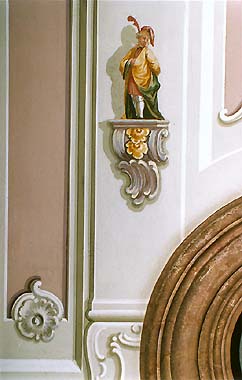Červený Dvůr Castle
Location:
The Červený Dvůr castle is located 8 km to the north-west of Český
Krumlov, on the south-east foothill of Kleť Hill near-by the road
connecting Český Krumlov and Chvalšiny. It is situated 550 metres
above sea level.
Origin of the Name:
It is said that the name of Červený Dvůr was not derived from the
colour of the roof (as it was in the case of Červená Lhota castle)
but it is only a mutilation of the German word to clear a place of
something - before "rothen", now "roden". The so-called new yard of
Chvalšiny was founded in the end of the 16th century probably on a
cleared place.
Description of the Place:
Now the spacious area consists of the castle building itself that
together with adjacent out-buildings closes a big rectangular
courtyard and further the remarkably spacious landscaped park
(
Červený Dvůr Castle - Park) of an area of 15 hectares with a
number of preserved garden buildings and fountains in the Romantic
style. The Baroque castle is an rectangular, one-wing building, the
front side is divided by a salience with a balcony, which ends in a
triangular shield and is covered with an attic roof. The facade is
articulated by lesenas. Cylindrical and groined vaults are on the
ground floor, the room on the first floor has a flat ceiling.
Architectural and Historical Development:
The so-called new yard of Chvalšiny was the predecessor of the
castle and it was founded by Wilhelm von Rosenberg at the foot of
Blanský les (Blanský forest) in 1591. His brother and heir Peter
Wok von Rosenberg established here in 1598 a new garden where
beavers, pheasants, partridges and quails were bread in the same
way as in a reserve. Marie
Ernestine von Eggenberg, maiden name zu Schwarzenberg, ordered
the building of the castle in 1672. In its north wing a chapel was
made. During the last reconstruction a graffito decoration was
uncovered in the facade of the middle part of the castle and also
Renaissance frescos in one of the first floor rooms. We suppose
that the construction in 1672 covered not only newly constructed
Baroque castle but also the construction (or part of it) of the
original Renaissance summer house of the Rosenbergs. The duke
Adam
Franz zu Schwarzenberg (1680 - 1732) had the roof of the castle
covered with a pantiled roof. In 1736 water supply for the
fountains was made in the castle garden. Between 1748 - 1749 a
salla terrena (artificial cave) was built, it was decorated by the
painter Josef
Lederer (responsible for the decoration of the Masquerade hall
in Český Krumlov castle). The castle chapel was decorated by the
painter Schopper. Also the painters Aneis and Putz participated at
that time in decoration of the castle. The so-called China hall
with the Rococo wall paintings from 1756 is a work of art from the
painter František
Jakub Prokyš (apart from this he also painted the interior of
the Bellarie summer-house in the Český Krumlov castle gardens). In
1779 - 1781 the 18 metres wide and 45 metres long castle of that
time was extended by two 37 and 38 metres long and 11 metres wide
side wings. It was almost the accomplishment of the constructional
development of the castle building. A wooden veranda was built to
the garden facade of the castle in 1836. It was in 1846 replaced
with iron one, preserved to our times.
Significant Architectural Features:
We can consider some halls situated on the first floor as the most
valuable. Firstly there is the so-called China hall (see above) and
secondly two rooms decorated with Oriental paintings and stucco
decoration. An interesting hall decorated with French wall papers
from the 19th century has also been preserved. Within the castle
garden area a tomb from 1841 called Waltersruhe (Saint Cross
chapel) is situated.

|

|
History of the Place's Residents:
As it was already mentioned above, Červený Dvůr was originally
owned by the Rosenbergs. In 1602 it was sold with all the estates
of Český Krumlov to the emperor Rudolf II. von Habsburg and
remained in the ownership of this family until 1622 when it was
given by emperor Ferdinand II. von Habsburg to count Johann Ulrich
von Eggenberg. He was at the same time risen to a duke state. Later
in 1719 the Schwarzenbergs inherited the castle and also all the
Český Krumlov estates. The Červený Dvůr castle went through the
period of its highest prosperity under the rule of duke Josef
Adam zu Schwarzenberg (1741 - 1782). The castle interiors were
reconstructed in the Rococo style and also the castle park was
charmingly rebuilt. The Červený Dvůr castle and especially the
castle park had their second high period under the rule of duke
Josef Adolf II. zu Schwarzenberg (1833 - 1888). He was influenced
by his journeys to England where he was interested in, apart from
the architecture, also in the so-called English parks. Apart from
the romantic arrangement of the garden facade (building of a
veranda) he spent time with changes of the regular French gardens
into a landscaped park. The last owner was JUDr. Adolf, duke zu
Schwarzenberg (1890 - 1950). The estates he owned were confiscated
by the Gestapo in 1940. In May 1945 they were taken under the
Czechoslovak national administration and with a special law from
1947 passed over to regional ownership. When the region order was
cancelled the ownership of the estates was passed over to the
Czechoslovak Republic.
Present use:
Today the castle is used as a mental hospital. It is specialising
in alcoholism therapy and drugs dependence. Neither the castle nor
the park are open to the public.
(jo)





